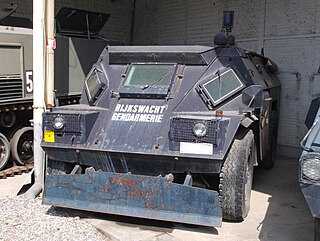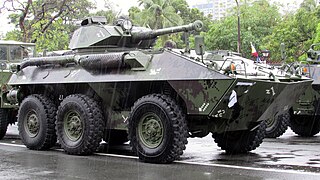 W
WThe FV601 Saladin is a six-wheeled armoured car developed by Crossley Motors and later manufactured by Alvis. Designed in 1954, it replaced the AEC Armoured Car in service with the British Army from 1958 onward. The vehicle weighed 11 tonnes, offered a top speed of 72 km/h, and had a crew of three. Saladins were noted for their excellent performance in desert conditions, and found favour with a number of Middle Eastern armies accordingly. They were armed with a 76 mm low-pressure rifled gun which fired the same ammunition as that mounted on the FV101 Scorpion.
 W
WThe BDX is a Belgian armored personnel carrier developed on the basis of the Irish designed Timoney armored vehicle.
 W
WThe Bravia Chaimite is an armored vehicle with all wheel drive axles built by the Portuguese company Bravia and used by the Portuguese Army in the Portuguese colonial wars in Angola, Mozambique and Portuguese Guinea, from 1967 to 1974 when it ended. The Chaimite was originally an unlicensed derivative of the Cadillac Gage Commando assembled and later produced in Portugal, with a number of improvements and technical modifications.
 W
WThe Cadillac Gage Commando, frequently denoted as the M706 in U.S. military service, is an American armored car designed to be amphibious. It was engineered by Cadillac Gage specifically for the United States Military Police Corps during the Vietnam War as an armed convoy escort vehicle. The Commando was one of the first vehicles to combine the traditionally separate roles of an armored personnel carrier and a conventional armored car, much like the Soviet BTR-40. Its notable height, amphibious capability, and waterproofed engine allowed American crews to fight effectively in the jungles of Vietnam by observing their opponents over thick vegetation and fording the country's deep rivers.
 W
WThe EE-9 Cascavel is a six-wheeled Brazilian armoured car developed primarily for reconnaissance. It was engineered by Engesa in 1970 as a replacement for Brazil's ageing fleet of M8 Greyhounds. The vehicle was first fitted with the Greyhound's 37mm main gun, and subsequently, a French turret adopted from the Panhard AML-90. Later models carry unique Engesa turrets with a Belgian 90mm Cockerill Mk.3 cannon produced under licence as the EC-90.
 W
WThe Eland is an air portable light armoured car based on the Panhard AML. Designed and built for long-range reconnaissance, it mounts either a 60mm (2.4 in) breech-loading mortar or a Denel 90mm (3.5 in) gun on a very compact chassis. Although lightly armoured, the vehicle's permanent 4X4 drive makes it faster over flat terrain than many tanks.
 W
WThe FV721 Fox Combat Vehicle Reconnaissance (Wheeled) was a 4 × 4 armoured car manufactured by ROF Leeds, deployed by the British Army as a replacement for the Ferret scout car and the Saladin armoured car. The Fox was introduced into service with B Squadron, 1st Royal Tank Regiment in 1975 and withdrawn from service 1993–94.
 W
WThe Cadillac Gage LAV-300, originally named the V-300, is a family of American light armored vehicles (LAVs) including up to 15 configurations. It was originally created and designed by CG as a private venture project.
 W
WThe Panhard AML is a fast, long-ranged, and relatively cheap armoured car with excellent reconnaissance capability. Designed on a small, lightly armoured 4×4 chassis, it weighs an estimated 5.5 tonnes, and thus suitable for airborne deployment. Since 1959 AMLs have been marketed on up to five continents; several variants remained in continuous production for half a century. These have been operated by fifty-four national governments and other entities worldwide, seeing regular combat.
 W
WThe Panhard E.B.R. is an armoured car designed by Panhard for the French Army and later used across the globe, notably by the French Army during the Algerian War and the Portuguese Army during the Portuguese Colonial War in Angola, Mozambique and Guinea-Bissau.
 W
WThe Shorland is an armoured patrol car that was designed specifically for the Royal Ulster Constabulary by Frederick Butler. The first design meeting took place in November 1961. The third and final prototype was completed in 1964 and the first RUC Shorlands were delivered in 1966. They were reallocated to the Ulster Defence Regiment in 1970. The Royal Ulster Constabulary soon replaced the Shorland with an armoured Land Rover with more conventional profile and no machine gun turret.
 W
WThe Sonder Kfz-1 and SK-1, also known as Garant 30k SK-1, was an East German armored patrol vehicle introduced by the East German Police in 1953. It was used by the Kasernierte Volkspolizei and for a short time by the National People's Army. The SK-1 is the chassis of a Robur Garant 30K truck fitted with an armored body and a light turret. There is a door in the rear of the hull for the crew to enter, and a hatch on top of the turret. The turret has several vision slits and a hole for a machinegun. With the reunification of Germany, most of the SK-1s were scrapped, except for some sent to museums or private collectors.
 W
WThe Spähpanzer Luchs is a German 8x8 amphibious reconnaissance armoured fighting vehicle (Spähpanzer) was in service from 1975 to 2009 with the German Army, who used 408 in their armoured reconnaissance battalions. It was developed by Daimler-Benz between 1968 and 1975, replacing the M41 and the Schützenpanzer SPz 11-2 Kurz.